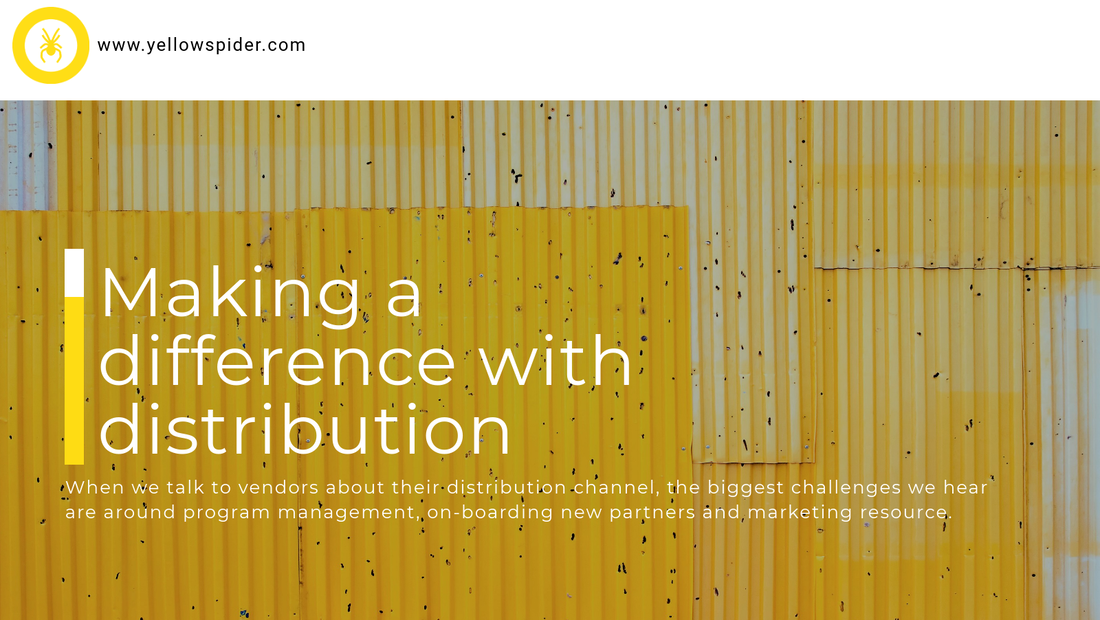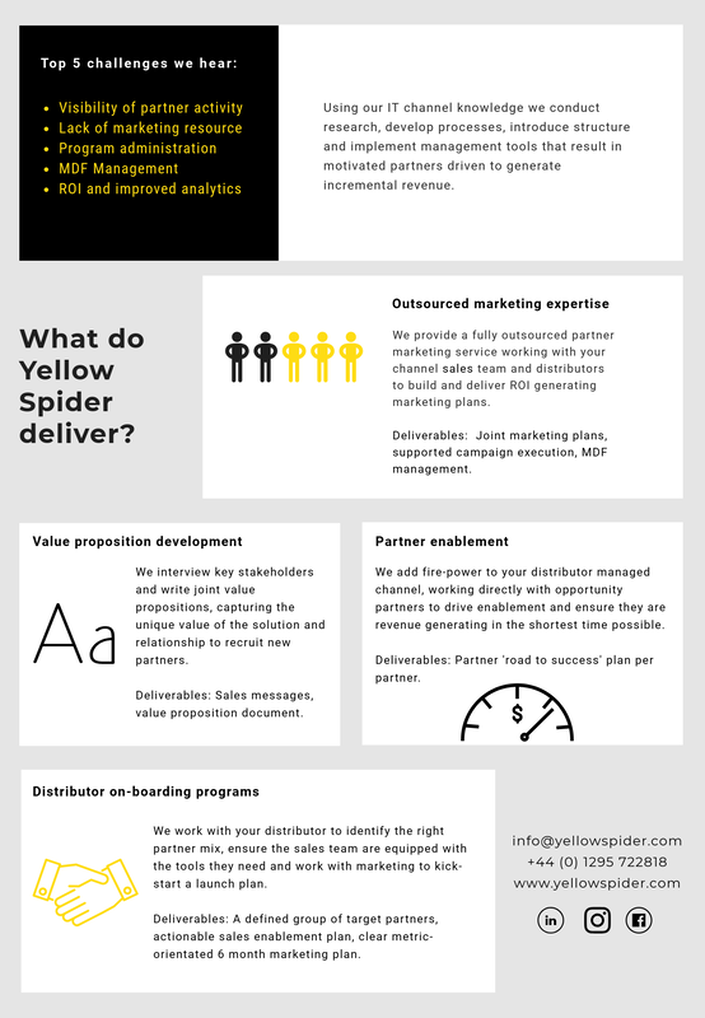 We love data at Yellow Spider, mainly because it provides so much insight that we use to improve our clients marketing outreach. During these times of reflection we are supporting a number vendors who are revisiting and analysing their data to make sure it is providing them with maximum value. Our main focus is to highlight opportunities for growth which are often overlooked or missed. We have developed a tool that combines data and intelligence gathered through the sales and marketing process to identify specific behaviours and buying preferences. This allows us to create groups of customers with similar characteristics resulting in effective segmentation and identify clearly defined groups of opportunities:
This method of segmentation helps to define marketing activities, go to market strategies and messaging for targeted nurture campaigns aimed at driving specific outcomes or responses. It’s powerful insight and is particularly relevant to organisations selling through a two-tier model. Information gathered can be used to strengthen channel relationships and build more effective (and mutually lucrative) engagements through a programmatic approach. The benefits of taking a fresh look at your data are clear and by introducing a regular cadence of analysis patterns start to emerge. Once the framework is in place it’s easy to run the analysis on a quarterly basis as a temperature check or to measure the effectiveness of sales and marketing campaigns. To find out how we can help you maximise your data and optimise your channel engagements please get in touch.
0 Comments
A few ways to create extraordinary business impact, punch above your budget and stay sane Fulfilling a Field Marketing role, especially in a region far from HQ and in a different language than the corporate one can be both a daunting and amazing task. You are the person who “just makes it happen” locally, at the same time as you provide feedback and guidance around media, messages and more to the organisation. Not seldom is this a position that requires the personality of a cheerleader, a coach and a referee at the same time. And that’s also what makes it so rewarding! We are sharing a few of our lessons learned here, in the form of tricks to this role, when you want to make sure Field Marketing is fulfilling both for the organisation, and for you! Become a market expert Make it your business to understand the local market and the local business beyond the traditional marketing scope. We have all collected, read and analysed public data about the market, reports about competition and found them useful. But there is also a real value in ensuring visibility of sales and pipeline data and taking part in sales calls, updates and reviews. Build relationships with sales, create a regular dialogue and build your insights into your plans pro-actively. Combine this with analysis of your database, and you can start a segmentation and targeted campaigns. It will seem a bit like magic, and you might also pick up on some customer references at the same time. Create a virtual team of contributors and stakeholders How many times have we asked a technical expert for “a favour” when it comes to reviewing marketing material with short notice? That might still happen… but there is great benefit in pro-actively creating a small virtual marketing team of people from different parts of the business around you. In addition to those who are trained spokes people, recognised speakers etc, invite colleagues who can provide feedback from clients. Formalise it with short monthly update calls, ensure that recognition is given and dialogue is encouraged. You might be amazed by how willing others are to contribute, given some notice. Pick a few, integrated campaigns It might sound obvious, but if you are in a region, or just a team of one or two, the importance of sticking to a few focused integrated campaigns can hardly be exaggerated. Make sure you are plugged in and collaborate with centralised functions across the organisation, leverage platforms and test automation tools. Review the impact of your campaigns against objectives on a regular basis and share the results internally. If you are part of the central team, or leading a group across regions, ensure that there are KPIs and campaigns goals related to local achievements.Raise your hand to be an early-adopter as long as it aligns with your chosen message and is based on your market knowledge. That extra support and structure might give you some room for flexibility to support a last-minute request or two and “make it happen”. Build and maintain partnerships To create impact and scale, partner with the best, the strategic and those that have as much to benefit from collaboration as you do locally. If you work for a vendor, expectations are usually high for Channel Partners to be main contributors to demand and pipeline. Whilst managing the channel engagement is someone else’s fulltime job, we can plug in and ensure marketing is included in sales plans, that channel partners are supporting our messages to market on websites, in newsletters to their database and via events. Communicate, communicate and communicate is the name of the game. Just as impactful as channel, let’s not forget alliances where marketing can play a significant role especially early in the sales cycle, as part of account based work and for branding. Alliances can play a significant role in marketing objectives and achieving targets – and the benefit is usually mutual. Everybody wins! Be selective about content localisation You’re the expert on communicating in your region. You understand the mentality, know the suitable tone and see what competitors and partners are saying. If your local language is not English, you are both in a good and a tricky situation. Spending too much time on localisation is an easy trap to fall into – as well as an opportunity to get the content “just right”. We need to consider the true local impact, especially in regions where English is accepted and sometimes even preferred. Having a landing page translated to local language can be important, but put this into comparison to taking that time for a discussion with clients or prospects. Thinking twice can help even when we are experts. Read more about content localisation Change the way you perceive your role, and your role in the business might change Field Marketing can sometimes feel like being at the receiving end of content, campaigns, reporting requests and a “long list of implementations” to get done. When we represent an organisation in a region we can really use this to our advantage and turn this on the head – become a contributor of content, customer references and feedback on activities, a subject matter expert in specialised parts of the marketing portfolio and provide business impact by aligning with sales locally and be bold as an early-adaptor within the organisation. This might sound more like hard work than magic, but we believe the results make it very worthwhile. And at Yellow Spider we welcome hard work for the right results, and will be happy to provide some magic to your organisation too. Contact us to find out more about how we can support you in shaping your team, establish and hone your processes or fulfilling roles in the field.
For vendors new to the market, the first two years of building a successful channel are the most difficult. It is likely you already have some established competitors with an established channel and a ‘partner program’ being executed with varying levels of success, all have shiny incentives to grab channel attention. If you’re the new kids on the block and you want to attract and retain new partners, you need to stand out from the crowd. Our advice is don’t run before you can walk. Take time to build your strategy, value proposition and support network before you start recruiting partners, this way you ensure your initial investment in channel development provides a return. Using our experience of working with leading Global IT vendors, we’ve developed our own recipe to channel success. This article outlines the building blocks you should think about before you even start a conversation with a channel partner. It’s all about profile. Knowing the profile of partner that you want to target and how you can attract their attention will focus your marketing efforts on the right people (we advise quality here, not quantity). Don’t fall into the trap of simply buddying up with the biggest names, spend time understanding who is best suited to your business; it could be the ones you least expect! Have a plan. I know, it sounds simple but so many people forget it! Having a clearly defined marketing plan aligned with sales goals is the first step on the road to sustainable revenue for both you and your channel partners. Structure. Be clear on what your channel engagement looks like. That includes knowing how you’re going to work with your distributors as well as understanding what type, and how many, partners you need to join forces with to deliver your strategy. Be attractive. What makes your proposition valuable? Ensure you have a well-defined process for articulating and delivering value to your channel. This could be through a programmatic engagement or a range of benefits delivered via joint marketing arrangements. You can have the best program in the world but unless you communicate product and solution value and offer your channel an opportunity you’ll struggle to grab your partners attention. Support. Establish your support mechanism from the get go. This includes the tools, processes and people you’ll need to manage your channel relationships as well as any training and certification required to sell and support your products. Consider language requirements and how you will support joint marketing initiatives, lead gen activities and market development funds. In the early days, successful vendors support partners with joint marketing planning and campaigns; until you’ve got an established channel it’s a more effective than giving them marketing funds. Easy does it. In a competitive market partners are going to work with vendors who are easy to do business with and ones who make it easy for them to grow their own revenue. Make the onboarding as simple as possible for partners, with plenty of onboarding milestones and clear lines of communication back into your organisation. Partners have access to several different vendor portals so make yours simple with clear training modules and fund management tools that allow partners to track their success and download sales and marketing support materials.
When we speak about marketing strategy or campaigns these days the complexity and possibilities can feel endless. There has never been more choice of tactics, platforms and channels available to support marketing activities, however for this same reason companies feel compelled to use everything and “be” everywhere; sometimes lacking a solid plan or strategy to manage and orchestrate it all. I've compiled our 5 top tips to audit your marketing strategy and make the necessary tuning: Define your objective Whether you are planning a social media campaign, an event campaign or your digital campaign for the year it is fundamental to have a clear goal. Are you aiming for brand awareness? event registrations? demand generation? If you don’t know what you want to achieve, you don’t have purpose, and without purpose your actions will be weak. Setting clear objectives and establishing KPIs will enable you to measure campaign performance and make the necessary optimisation changes when needed. Establish a timeframe Every marketing campaign needs a start and an end. This is connected to the purpose but also to the measurement concept. You can, and should, define milestones within the campaign which might have different sub-objectives but at the end of the day they should all set your campaign cadence and contribute to the ultimate campaign objective. Know your contacts Data is usually messy and disorganised. This is an area of planning that is constantly overlooked and often the key failing in an unsuccessful campaign. We know data can be boring, and sometimes even scary, but it is worth going through a healthy database audit exercise from time to time. The best campaign in the world is useless if it doesn’t reach the right target audience. Pick your tactics Website, email, podcast, video, organic social, paid social, print elements…you name it. Possibilities are endless, but your time and resources are not. You need to select your tactics carefully, have a plan, build a cadence and set a goal for each tactic type or channel. Don’t fall into the trap of viewing each tactic type in isolation, trying to use them all at the same time or with the same frequency. Tactics should complement each other like instruments in an orchestra. Build relevant content Taking the four steps above should help to personalise and target your content as you will know what you want to communicate, by when, to who and where. Remember it is not about what you want to say about your company or your event, but more about what your target audience’s issues, needs, questions or desires are. Why respond to you? Yellow Spider support clients with defining marketing and campaign strategies, and offer managed services to build and run campaigns on your behalf. If you would like to know more, need inspiration or help tuning your marketing strategy, just get in touch! You may have seen our recent blog posts on what we do – B2B channels, outsourced marketing resource , event management and social media management. Plus lots of other clever, B2B marketing stuff. We’re proud of what we do, because we know it drives results for our clients. But this time, instead of focussing again on what we do, I wanted to talk a little about how we do it. More specifically, about where we see the greatest success. One of the greatest benefits of bringing in help from a company like Yellow Spider is that, by definition, we are ‘external’. That means we don’t come with any preconceptions of you, your team or organisation, or what you are trying to achieve. We’re respectful of all of those things. Our team’s combined experience means we have over 100 years B2B marketing know-how. It’s quite likely that not only can we help you with the specific project you’ve hired us for, but that we can also provide added value in the elements that connect to it. ‘Added value’ as a term is so over-used today that I hesitate to re-use it here. But it genuinely drives the Yellow Spider philosophy. We don’t charge in with off-the-shelf solutions. We take time to understand your objectives. We tailor our solution to your circumstances, and where you are trying to get to. We bring structure where there was none. We bring insight from our combined experience working deep within the world’s top tech companies. And fundamentally, we get things done. Sounds simple, doesn’t it? But in today’s business environment, there can be many blockers to progress, or simply achieving objectives. There can be great value in having someone bringing a fresh perspective. All this talk of ‘external’ brings me to the main point of this blog. And that is, that we consistently see the greatest successes within clients where we shed the tag ‘external’ and are considered part of the team. We’re proud to say it’s a position we have earned across our client base. I’ll take a recent example from one of our clients. They have invested heavily, at a global level, in an intent database that aggregates data across their various applications. They aimed to use the data to better target their marketing campaigns. We requested access to this tool and immediately saw the huge, additional value of it in assisting not only the targeting but in marketing strategizing, decision-making and planning. And not only in the country we are charged with supporting, but across EMEA. We took the initiative, and without being asked, invested time to understand the data, manipulate it and compile a ‘story’ to propel a joint marketing and sales program to understand more about these accounts and how our client can win them. It’s something that could only happen because the client considered us one of them – we have access to the same resources, knowledge and people that everyone else in the team has. We’re successful when our client is successful, or more succinctly, we look good when our client looks good. That’s what drives us, individually, collectively and as a business. If we’re not successful, we no longer have a job. There’s an added edge that means we are, and have to be, ‘Marketing+’. It can be hard to admit ‘this could be better!’, ‘we need help!’, or even ‘I don’t know what I’m doing!’. But the potential benefits of doing so are massive. Get in touch for an informal chat about how we might be able to turbocharge your marketing. Or just help you get things done. Because sometimes, we more than understand, it’s just not that simple. Marketing teams often use the terms 'translation' and 'localization' interchangeably. Even field teams who are engaged in both processes tend to default to the term 'translation'. They are however, very different, and our understanding of those differences is part of the bigger picture of how our audiences engage with us, so it is vital that we have a solid grasp of how they are distinct. Translation is literal, but whilst this means that the text will be expressed 'word for word', grammar and syntax need to be taken into account if the translated text is to make sense. However, whilst translation makes allowances for the differences in the structure of languages, it makes no attempt to interpret the content to ensure that the meaning is something the reader would expect and understand. That is where localisation comes in. Before we come to that, it is interesting to note that some content is deliberately translated rather than localised to ensure it is strictly uniform. Publication groups delivering technical, process, procedural and legal documentation may treat content this way out of choice. In these specialised use cases this can be a valid approach because the content is much less subject to cultural influences. In some use cases, such as safety critical equipment documentation, it might actually be dangerous to interpret the translation in order to localise it. For other uses, and particularly for customer facing content, we apply localisation, as our goal is not just to translate the text but to ensure it is truly equivalent to the source text on the audience's terms. There is more work involved in achieving this. An article inComputer World describes the process well: "This is a more involved process whereby the target-language content is adapted to more effectively convey a similar meaning or connotation in the target culture. Idiomatic expressions, puns and marketing material generally fall into this category, but localization can apply to any type of content based on what your business objectives are. The key point here is that your target-language version will often not be a literal translation. As an example, if you want to convey the phrase "Like father, like son" in Chinese, it would read as something like "Tigers do not breed dogs." Although this doesn't match up with the source content, it has the same connotation in the target culture." Localisation goes beyond the translation of words to ensure that one piece of content is equivalent to another in how the audience will engage with it. To do this it has to address word selection, particularly in adjusting the tone, the use of expressions (many of which do not translate very well) and any references made. Excellence in localisation requires attention to details such as capitalisation (which is different between German and English for example) and any salutation used (some countries expect the salutation to align with academic qualifications). Failure to pay attention to how the audience expects to be communicated with will inevitably result in lower engagement. Ultimately, localisation has to interpret the objectives of the content and adapt it to meet those objectives. This requires local knowledge, not just of the language but of the people of the country or region; including how they think, conduct business, and live their lives. It requires empathy, which can be defined as 'the ability to understand and share the feelings of another.' If this sounds overly sentimental, it isn't - it is good business and helps establish sound foundations for engaging with an audience. Corporate Visions use the phrase 'talk to me like you like me' to capture the empathy necessary to build engagement, and that is an essential part of Marketing today. The fact that our audiences are different, and that engaging them requires some local knowledge, is part of what makes Marketing such an interesting profession.
Many organisations view events and trade shows as a necessary evil rather than strategic lead generating activities, while most also admit spending a significant portion of their budget on them. As the New Year is underway and the deadline for finalising 2018-19 marketing plans is looming if not already past, I would like to share some of my top tips for getting the most value from your event participation. 1. Start early Trade shows are a major investment. Many marketers spend over a third of their annual budget on events. Start planning at least nine months prior and make sure that all key stakeholders are engaged and actively involved in the strategic development process. 2. Have a plan. Better yet, have more than one Create an overall event plan for your region establishing a show selection criteria to ensure you are reaching your desired target audience. Develop a strategic plan for each event setting measurable objectives, outlining message strategy and detailing marketing initiatives. Most importantly, once you have created your plans - stick to them! 3. Execute pre-event marketing Consider your objectives and execute pre-event email, social or direct mail campaigns accordingly. Pre-event campaigns should have a clear, measurable call to action such as booking an appointment or stopping by your booth. 4. Create your own audience Don’t focus marketing efforts solely on the event delegate list or rely on the event organiser to drive traffic to your booth. Instead capitalise on your own resources by focusing your pre-show marketing on your customer base, leads from previous shows or web generated contacts. Your current customers are the most likely to be interested in new product information and the opportunity to meet with key executives or to have questions answered by technical experts. 5. Create a team Your booth staff are your key to success so choose valuable team members. Make sure all show staff are briefed on the show strategy and understand how to utilise all of the stand resources before the event. Be strict with your stand rules – i.e. no mobile phones, laptops, etc. Make the best of the time you have with prospects and customers. 6. Promotional items Promotional items do not have to be expensive, but they do have to be relevant. Make sure give-aways effectively represent your brand and are something useful for your customer. Give everyone a reason to carry or wear your brand such as a chance to win a grand prize at the end of the day. 7. Prize give-aways Who doesn’t like to win something? Grand prizes add excitement and can create a buzz around your booth especially if you tie the entry into a quick, fun game or competition. Excitement can be created with items ranging from the newest technology gadget to the latest Star Wars themed Lego kit. 8. Follow-up It can be easier said than done at a busy booth, but it’s imperative to input notes and capture information regarding each conversation and booth scan. Whether it’s a phone call or email, follow-up will likely be more well-received if it is personalised. Collate and distribute the show information so that hot leads can be followed-up directly by account managers. 9. Measure your ROI Know going into the show how you are going to measure success and define how you will measure each marketing technique and its effectiveness. If your business goals include driving inflow, accelerating pipeline, building brand awareness, promoting thought leadership and strengthening partner relationships then set measurable targets. 10. Event wrap-up Lastly, create an event summary report. You will be glad you did when it’s time to consider renewing event sponsorships. Summarise all of the events details, get honest feedback from your event team, analyse your goals and recap what worked and what didn’t work. To sum it up, executing a successful trade show involves a great deal of advanced strategic and tactical planning, attention to detail and targeted follow-up. Marketing automation solutions can revolutionise the effectiveness and understanding of your campaigns, but choosing the right one is critical. Many put off the decision for as long as possible due to the investment required both in man hours and finances so when the time comes and you need to bite the bullet you want to know you have selected the right one for your business. Here I share with you my 6 advices for a quick evaluation of marketing automation platform. If you follow these key rules you will have a platform that is fit for purpose and meets your marketing requirements: Functionality What do you actually want the platform to do for your business? Sounds like a simple question but it’s easy to get distracted by the advanced features some platforms offer. Be really clear on what it is that you need it to do and only look for the features you will have an use for. Timeframe The amount of time you have to implement a new marketing automation platform will help you decide whether you go down the ‘built your own’ route or select an ‘off the shelf’ product. Both have their pros and cons but bear in mind that regardless of which route you choose it’s going to be at least eight to 12 weeks before you have a fully functioning platform. Integration How is the new platform going to integrate with any existing tools you currently use? If you have a CRM system it is worth talking to your existing supplier to see whether they have a suitable marketing platform as well. This could save time, cost and will ensure all of your on line tools work harmoniously. Scale Make sure you select a platform that can grow with your business. You are probably clear on the functionality needed today but what does your business look like in five years’ time and does the platform you are considering offer the ability to scale up when you need it to? Ease of use Despite all of us being IT savvy and more than capable of driving on line and self-serve technologies, make sure the tool you select doesn’t require a master’s degree to understand it! It only takes one bad experience to put an employee or partner off using a platform no matter how great it is so make sure you evaluate the user experience. Success metrics As with any marketing activity you need to be able to demonstrate success and ROI. Choose a platform that allows you to create, view and export reports that show how your campaign has performed and identifies trends that will shape future campaigns. Over recent years we have seen how the perception of marketing has evolved from being a cost centre to playing a fundamental role in driving and generating sales revenue. Demand generation has got sophisticated, and use of data has allowed marketing teams to achieve results that we only dreamt of years ago. Here we outline our top 5 tips to help you drive the most opportunities from your demand marketing strategies. Plan multi-touch, integrated campaigns. The days of single activity campaigns are over. The way we consume content in this digital age means we need to evolve our marketing tactics and use digital to drive awareness and action. It will take multiple touches before your audience will engage with you. Within each of your campaigns plan a mix of tactics, content and media to plan for a minimum of seven engagements or touches with your audience. Tailor your campaigns. A savvy buyer is spoilt. We have all come to expect the information we need to be presented to us in a way we wish to consume it. So take this philosophy and apply it to your messaging. Spend some time with sales learning about your customers, and build up a picture of what the buying groups look like. Then create message frameworks to tailor the message you want to give, to make it relevant to your segmented audience. Use the same thinking to tailor the way you deliver the message. Do your technical communities like a different style of communication to the CEO? Yes, more than likely. Adopt lead qualification and lead scoring. Understanding the leads you gather, and how best to follow them up is an often over looked part of the demand process. But if you think about it logically, are all leads created equal? To score your leads you must first create a scorecard against which all your leads can be measured. These typically follow the BANT methodology (Budget, Authority, Need, Timeline), but consider too other factors depending on your lead source - you can ascertain interest from event leads where you’ve had a conversation with the prospect, engagement through a digital campaign where you can track their behaviour and demographics where you have data available to understand a prospects company and situation. Use the scorecard to define your lead follow up strategy - Which need immediate follow up? Which need nurture? Which to disqualify? Nurture your prospects. Like every good gardener knows, nurturing young seedlings will grow strong healthy plants. Work with sales to understand the sales cycle, agree clear sales stages and decide what support and content you can provide to your prospects to help move them through the stages. Then devise a content plan and nurture campaign to deliver timely, relevant messages to support your prospect’s buying decisions. Build a relationship with sales. As you’ve hopefully picked up on so far, none of this can be achieved without the support and buy in from sales. You need mutual trust and respect between sales and marketing, with shared language, common goals and agreed processes - only then can your demand strategy reach it’s potential. |















